Evaluating Resource Allocation: Age, Health, and Ethical Dimensions
VerifiedAdded on 2023/06/05
|8
|2369
|474
Report
AI Summary
This report examines the complexities of resource allocation and prioritization within healthcare systems, particularly focusing on the role of age as a factor in decision-making. It reviews various research studies and public opinion surveys to understand differing perspectives on whether older or younger patients should receive priority in resource allocation. The report considers economic principles such as cost-effectiveness, equity, and preference, alongside ethical concerns, to argue that age should not be the sole determinant. Instead, factors like the complexity and urgency of health conditions, potential for maximizing benefits, and ethical considerations of fairness and autonomy should guide resource allocation decisions. The study emphasizes the importance of equitable access to resources, regardless of socioeconomic status, and advocates for a balanced approach that considers both the immediate needs and long-term outcomes in healthcare.
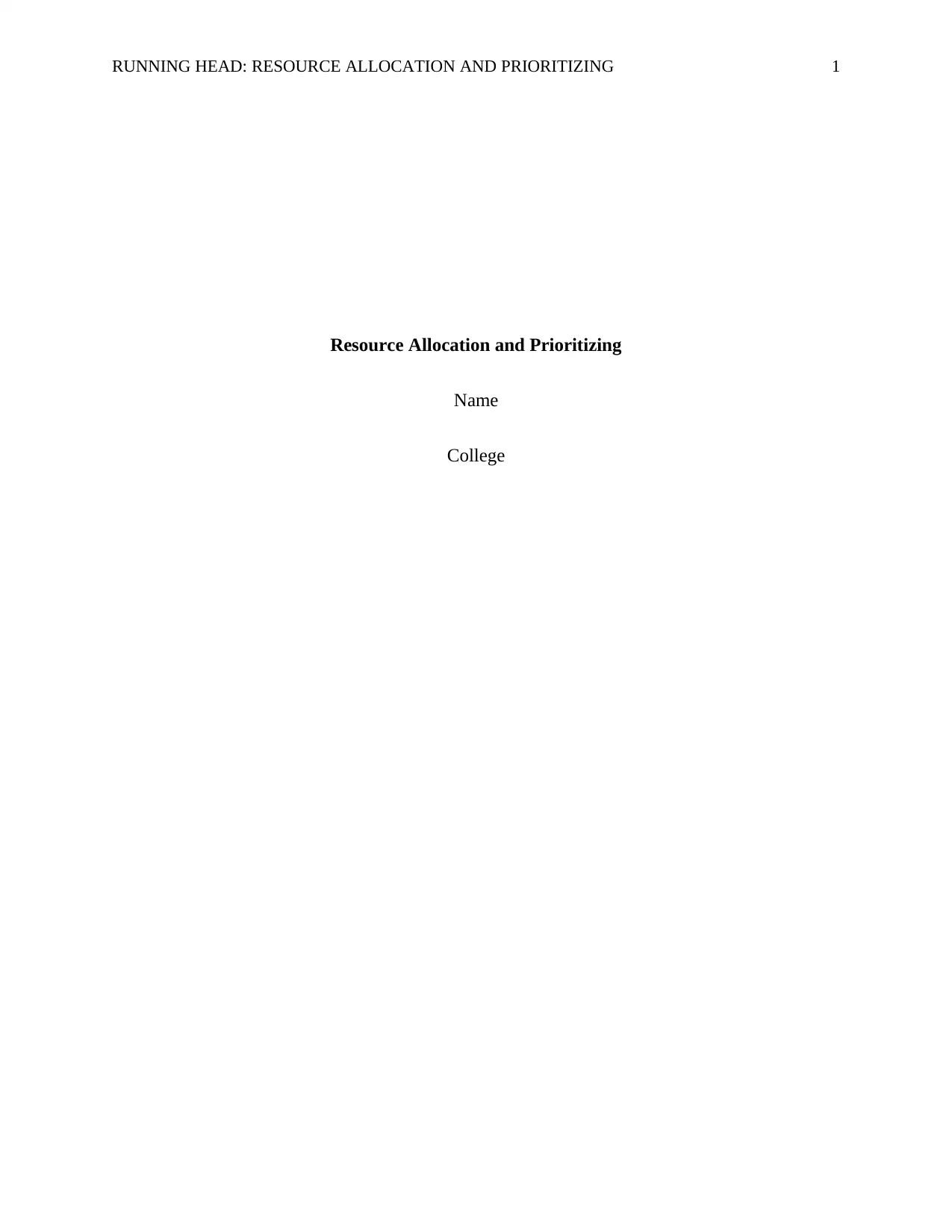
RUNNING HEAD: RESOURCE ALLOCATION AND PRIORITIZING 1
Resource Allocation and Prioritizing
Name
College
Resource Allocation and Prioritizing
Name
College
Paraphrase This Document
Need a fresh take? Get an instant paraphrase of this document with our AI Paraphraser
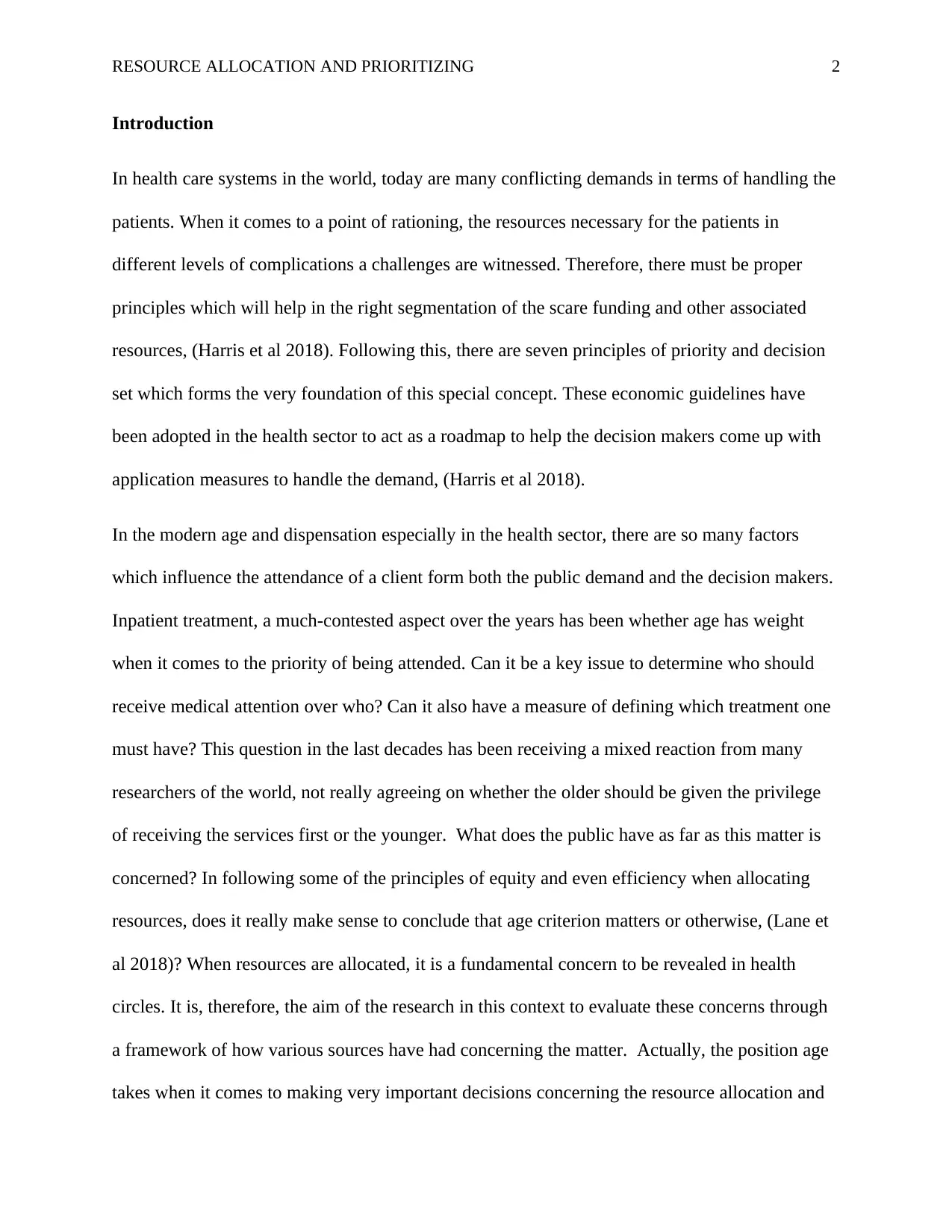
RESOURCE ALLOCATION AND PRIORITIZING 2
Introduction
In health care systems in the world, today are many conflicting demands in terms of handling the
patients. When it comes to a point of rationing, the resources necessary for the patients in
different levels of complications a challenges are witnessed. Therefore, there must be proper
principles which will help in the right segmentation of the scare funding and other associated
resources, (Harris et al 2018). Following this, there are seven principles of priority and decision
set which forms the very foundation of this special concept. These economic guidelines have
been adopted in the health sector to act as a roadmap to help the decision makers come up with
application measures to handle the demand, (Harris et al 2018).
In the modern age and dispensation especially in the health sector, there are so many factors
which influence the attendance of a client form both the public demand and the decision makers.
Inpatient treatment, a much-contested aspect over the years has been whether age has weight
when it comes to the priority of being attended. Can it be a key issue to determine who should
receive medical attention over who? Can it also have a measure of defining which treatment one
must have? This question in the last decades has been receiving a mixed reaction from many
researchers of the world, not really agreeing on whether the older should be given the privilege
of receiving the services first or the younger. What does the public have as far as this matter is
concerned? In following some of the principles of equity and even efficiency when allocating
resources, does it really make sense to conclude that age criterion matters or otherwise, (Lane et
al 2018)? When resources are allocated, it is a fundamental concern to be revealed in health
circles. It is, therefore, the aim of the research in this context to evaluate these concerns through
a framework of how various sources have had concerning the matter. Actually, the position age
takes when it comes to making very important decisions concerning the resource allocation and
Introduction
In health care systems in the world, today are many conflicting demands in terms of handling the
patients. When it comes to a point of rationing, the resources necessary for the patients in
different levels of complications a challenges are witnessed. Therefore, there must be proper
principles which will help in the right segmentation of the scare funding and other associated
resources, (Harris et al 2018). Following this, there are seven principles of priority and decision
set which forms the very foundation of this special concept. These economic guidelines have
been adopted in the health sector to act as a roadmap to help the decision makers come up with
application measures to handle the demand, (Harris et al 2018).
In the modern age and dispensation especially in the health sector, there are so many factors
which influence the attendance of a client form both the public demand and the decision makers.
Inpatient treatment, a much-contested aspect over the years has been whether age has weight
when it comes to the priority of being attended. Can it be a key issue to determine who should
receive medical attention over who? Can it also have a measure of defining which treatment one
must have? This question in the last decades has been receiving a mixed reaction from many
researchers of the world, not really agreeing on whether the older should be given the privilege
of receiving the services first or the younger. What does the public have as far as this matter is
concerned? In following some of the principles of equity and even efficiency when allocating
resources, does it really make sense to conclude that age criterion matters or otherwise, (Lane et
al 2018)? When resources are allocated, it is a fundamental concern to be revealed in health
circles. It is, therefore, the aim of the research in this context to evaluate these concerns through
a framework of how various sources have had concerning the matter. Actually, the position age
takes when it comes to making very important decisions concerning the resource allocation and
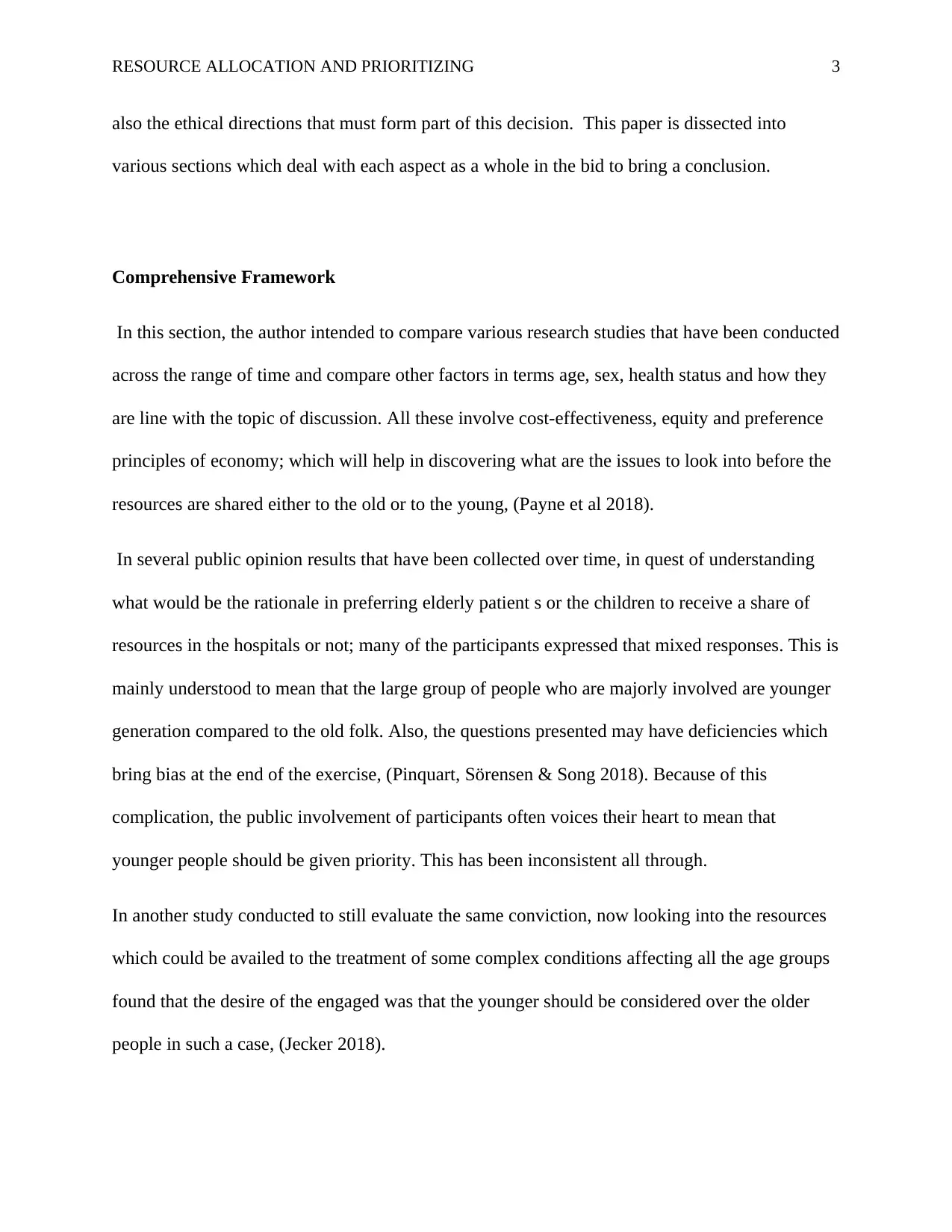
RESOURCE ALLOCATION AND PRIORITIZING 3
also the ethical directions that must form part of this decision. This paper is dissected into
various sections which deal with each aspect as a whole in the bid to bring a conclusion.
Comprehensive Framework
In this section, the author intended to compare various research studies that have been conducted
across the range of time and compare other factors in terms age, sex, health status and how they
are line with the topic of discussion. All these involve cost-effectiveness, equity and preference
principles of economy; which will help in discovering what are the issues to look into before the
resources are shared either to the old or to the young, (Payne et al 2018).
In several public opinion results that have been collected over time, in quest of understanding
what would be the rationale in preferring elderly patient s or the children to receive a share of
resources in the hospitals or not; many of the participants expressed that mixed responses. This is
mainly understood to mean that the large group of people who are majorly involved are younger
generation compared to the old folk. Also, the questions presented may have deficiencies which
bring bias at the end of the exercise, (Pinquart, Sörensen & Song 2018). Because of this
complication, the public involvement of participants often voices their heart to mean that
younger people should be given priority. This has been inconsistent all through.
In another study conducted to still evaluate the same conviction, now looking into the resources
which could be availed to the treatment of some complex conditions affecting all the age groups
found that the desire of the engaged was that the younger should be considered over the older
people in such a case, (Jecker 2018).
also the ethical directions that must form part of this decision. This paper is dissected into
various sections which deal with each aspect as a whole in the bid to bring a conclusion.
Comprehensive Framework
In this section, the author intended to compare various research studies that have been conducted
across the range of time and compare other factors in terms age, sex, health status and how they
are line with the topic of discussion. All these involve cost-effectiveness, equity and preference
principles of economy; which will help in discovering what are the issues to look into before the
resources are shared either to the old or to the young, (Payne et al 2018).
In several public opinion results that have been collected over time, in quest of understanding
what would be the rationale in preferring elderly patient s or the children to receive a share of
resources in the hospitals or not; many of the participants expressed that mixed responses. This is
mainly understood to mean that the large group of people who are majorly involved are younger
generation compared to the old folk. Also, the questions presented may have deficiencies which
bring bias at the end of the exercise, (Pinquart, Sörensen & Song 2018). Because of this
complication, the public involvement of participants often voices their heart to mean that
younger people should be given priority. This has been inconsistent all through.
In another study conducted to still evaluate the same conviction, now looking into the resources
which could be availed to the treatment of some complex conditions affecting all the age groups
found that the desire of the engaged was that the younger should be considered over the older
people in such a case, (Jecker 2018).
⊘ This is a preview!⊘
Do you want full access?
Subscribe today to unlock all pages.

Trusted by 1+ million students worldwide
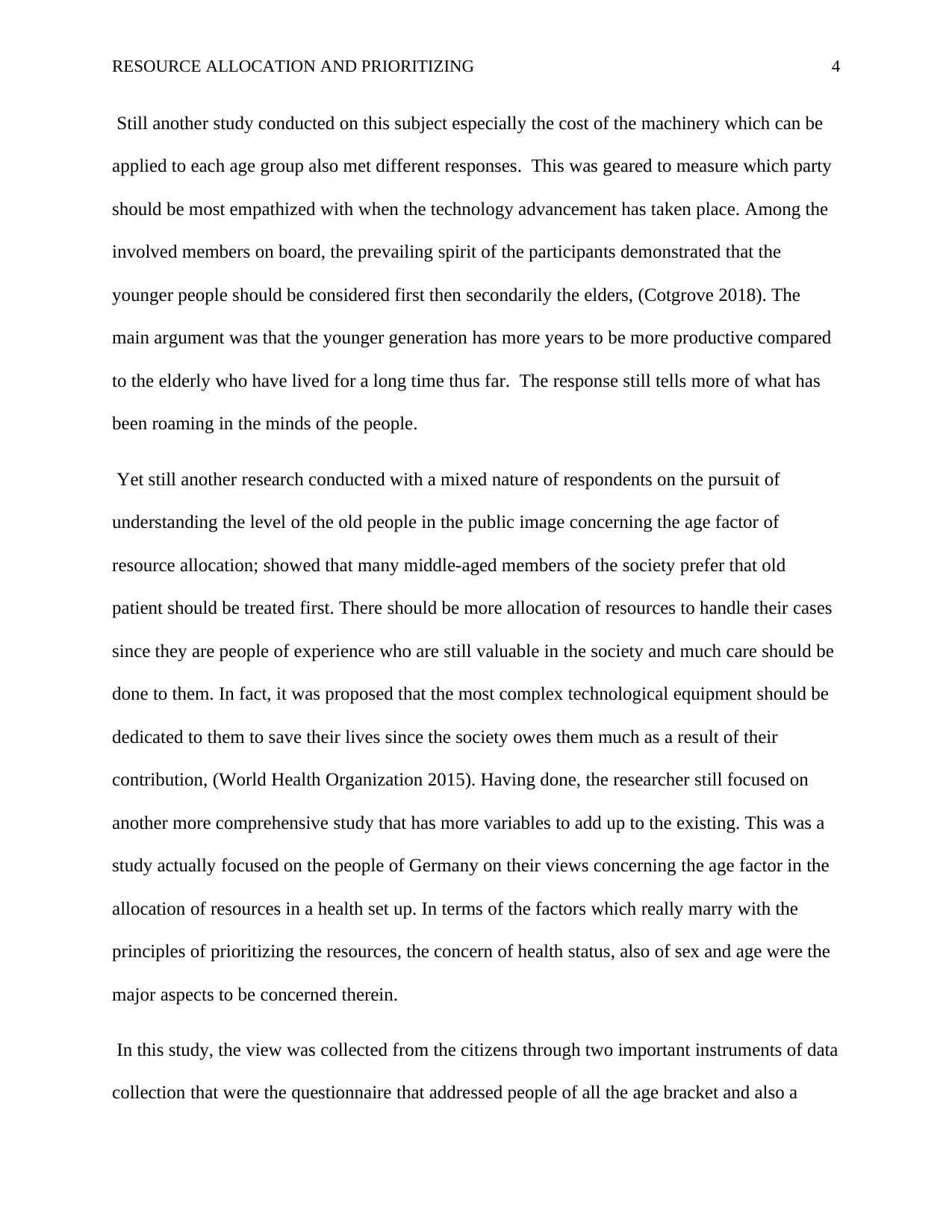
RESOURCE ALLOCATION AND PRIORITIZING 4
Still another study conducted on this subject especially the cost of the machinery which can be
applied to each age group also met different responses. This was geared to measure which party
should be most empathized with when the technology advancement has taken place. Among the
involved members on board, the prevailing spirit of the participants demonstrated that the
younger people should be considered first then secondarily the elders, (Cotgrove 2018). The
main argument was that the younger generation has more years to be more productive compared
to the elderly who have lived for a long time thus far. The response still tells more of what has
been roaming in the minds of the people.
Yet still another research conducted with a mixed nature of respondents on the pursuit of
understanding the level of the old people in the public image concerning the age factor of
resource allocation; showed that many middle-aged members of the society prefer that old
patient should be treated first. There should be more allocation of resources to handle their cases
since they are people of experience who are still valuable in the society and much care should be
done to them. In fact, it was proposed that the most complex technological equipment should be
dedicated to them to save their lives since the society owes them much as a result of their
contribution, (World Health Organization 2015). Having done, the researcher still focused on
another more comprehensive study that has more variables to add up to the existing. This was a
study actually focused on the people of Germany on their views concerning the age factor in the
allocation of resources in a health set up. In terms of the factors which really marry with the
principles of prioritizing the resources, the concern of health status, also of sex and age were the
major aspects to be concerned therein.
In this study, the view was collected from the citizens through two important instruments of data
collection that were the questionnaire that addressed people of all the age bracket and also a
Still another study conducted on this subject especially the cost of the machinery which can be
applied to each age group also met different responses. This was geared to measure which party
should be most empathized with when the technology advancement has taken place. Among the
involved members on board, the prevailing spirit of the participants demonstrated that the
younger people should be considered first then secondarily the elders, (Cotgrove 2018). The
main argument was that the younger generation has more years to be more productive compared
to the elderly who have lived for a long time thus far. The response still tells more of what has
been roaming in the minds of the people.
Yet still another research conducted with a mixed nature of respondents on the pursuit of
understanding the level of the old people in the public image concerning the age factor of
resource allocation; showed that many middle-aged members of the society prefer that old
patient should be treated first. There should be more allocation of resources to handle their cases
since they are people of experience who are still valuable in the society and much care should be
done to them. In fact, it was proposed that the most complex technological equipment should be
dedicated to them to save their lives since the society owes them much as a result of their
contribution, (World Health Organization 2015). Having done, the researcher still focused on
another more comprehensive study that has more variables to add up to the existing. This was a
study actually focused on the people of Germany on their views concerning the age factor in the
allocation of resources in a health set up. In terms of the factors which really marry with the
principles of prioritizing the resources, the concern of health status, also of sex and age were the
major aspects to be concerned therein.
In this study, the view was collected from the citizens through two important instruments of data
collection that were the questionnaire that addressed people of all the age bracket and also a
Paraphrase This Document
Need a fresh take? Get an instant paraphrase of this document with our AI Paraphraser
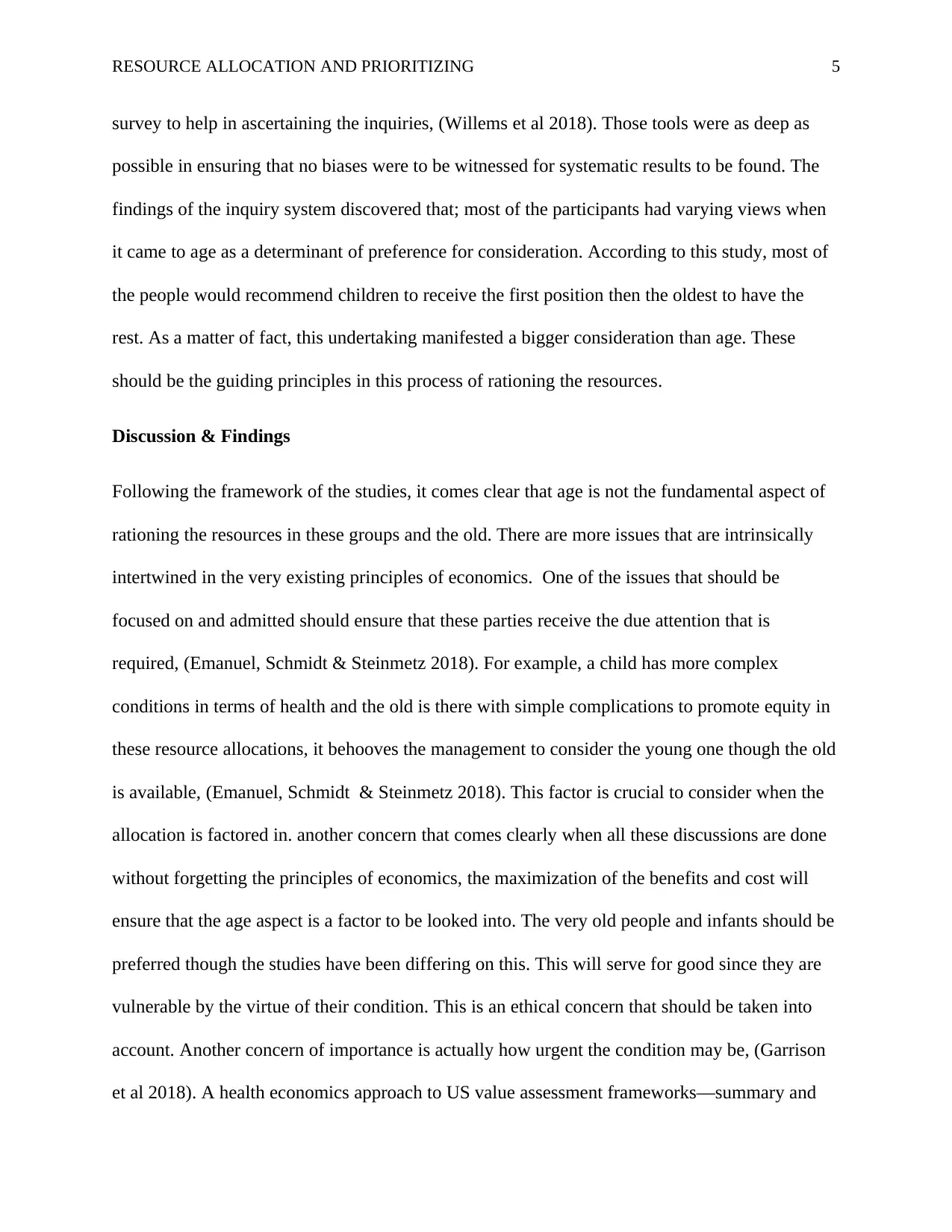
RESOURCE ALLOCATION AND PRIORITIZING 5
survey to help in ascertaining the inquiries, (Willems et al 2018). Those tools were as deep as
possible in ensuring that no biases were to be witnessed for systematic results to be found. The
findings of the inquiry system discovered that; most of the participants had varying views when
it came to age as a determinant of preference for consideration. According to this study, most of
the people would recommend children to receive the first position then the oldest to have the
rest. As a matter of fact, this undertaking manifested a bigger consideration than age. These
should be the guiding principles in this process of rationing the resources.
Discussion & Findings
Following the framework of the studies, it comes clear that age is not the fundamental aspect of
rationing the resources in these groups and the old. There are more issues that are intrinsically
intertwined in the very existing principles of economics. One of the issues that should be
focused on and admitted should ensure that these parties receive the due attention that is
required, (Emanuel, Schmidt & Steinmetz 2018). For example, a child has more complex
conditions in terms of health and the old is there with simple complications to promote equity in
these resource allocations, it behooves the management to consider the young one though the old
is available, (Emanuel, Schmidt & Steinmetz 2018). This factor is crucial to consider when the
allocation is factored in. another concern that comes clearly when all these discussions are done
without forgetting the principles of economics, the maximization of the benefits and cost will
ensure that the age aspect is a factor to be looked into. The very old people and infants should be
preferred though the studies have been differing on this. This will serve for good since they are
vulnerable by the virtue of their condition. This is an ethical concern that should be taken into
account. Another concern of importance is actually how urgent the condition may be, (Garrison
et al 2018). A health economics approach to US value assessment frameworks—summary and
survey to help in ascertaining the inquiries, (Willems et al 2018). Those tools were as deep as
possible in ensuring that no biases were to be witnessed for systematic results to be found. The
findings of the inquiry system discovered that; most of the participants had varying views when
it came to age as a determinant of preference for consideration. According to this study, most of
the people would recommend children to receive the first position then the oldest to have the
rest. As a matter of fact, this undertaking manifested a bigger consideration than age. These
should be the guiding principles in this process of rationing the resources.
Discussion & Findings
Following the framework of the studies, it comes clear that age is not the fundamental aspect of
rationing the resources in these groups and the old. There are more issues that are intrinsically
intertwined in the very existing principles of economics. One of the issues that should be
focused on and admitted should ensure that these parties receive the due attention that is
required, (Emanuel, Schmidt & Steinmetz 2018). For example, a child has more complex
conditions in terms of health and the old is there with simple complications to promote equity in
these resource allocations, it behooves the management to consider the young one though the old
is available, (Emanuel, Schmidt & Steinmetz 2018). This factor is crucial to consider when the
allocation is factored in. another concern that comes clearly when all these discussions are done
without forgetting the principles of economics, the maximization of the benefits and cost will
ensure that the age aspect is a factor to be looked into. The very old people and infants should be
preferred though the studies have been differing on this. This will serve for good since they are
vulnerable by the virtue of their condition. This is an ethical concern that should be taken into
account. Another concern of importance is actually how urgent the condition may be, (Garrison
et al 2018). A health economics approach to US value assessment frameworks—summary and
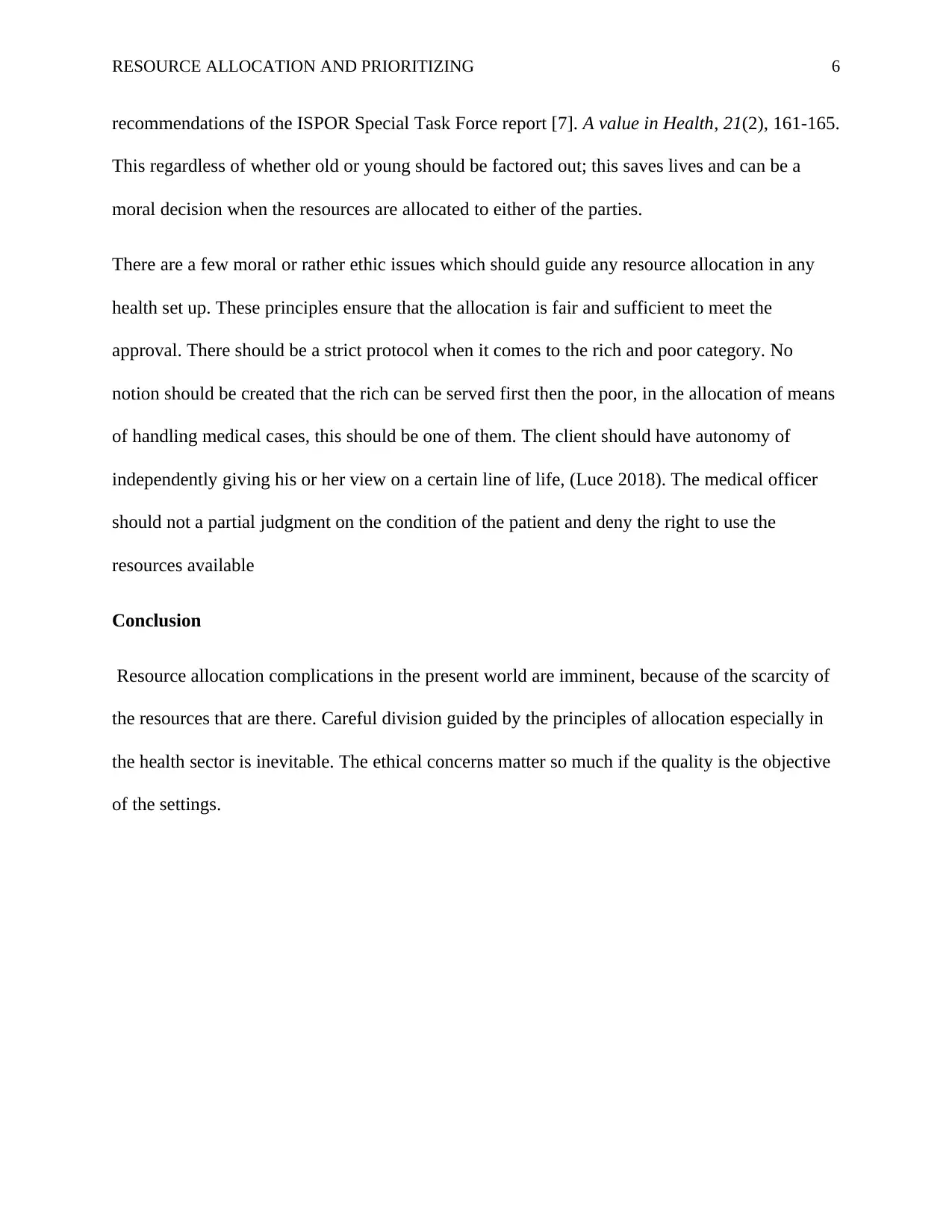
RESOURCE ALLOCATION AND PRIORITIZING 6
recommendations of the ISPOR Special Task Force report [7]. A value in Health, 21(2), 161-165.
This regardless of whether old or young should be factored out; this saves lives and can be a
moral decision when the resources are allocated to either of the parties.
There are a few moral or rather ethic issues which should guide any resource allocation in any
health set up. These principles ensure that the allocation is fair and sufficient to meet the
approval. There should be a strict protocol when it comes to the rich and poor category. No
notion should be created that the rich can be served first then the poor, in the allocation of means
of handling medical cases, this should be one of them. The client should have autonomy of
independently giving his or her view on a certain line of life, (Luce 2018). The medical officer
should not a partial judgment on the condition of the patient and deny the right to use the
resources available
Conclusion
Resource allocation complications in the present world are imminent, because of the scarcity of
the resources that are there. Careful division guided by the principles of allocation especially in
the health sector is inevitable. The ethical concerns matter so much if the quality is the objective
of the settings.
recommendations of the ISPOR Special Task Force report [7]. A value in Health, 21(2), 161-165.
This regardless of whether old or young should be factored out; this saves lives and can be a
moral decision when the resources are allocated to either of the parties.
There are a few moral or rather ethic issues which should guide any resource allocation in any
health set up. These principles ensure that the allocation is fair and sufficient to meet the
approval. There should be a strict protocol when it comes to the rich and poor category. No
notion should be created that the rich can be served first then the poor, in the allocation of means
of handling medical cases, this should be one of them. The client should have autonomy of
independently giving his or her view on a certain line of life, (Luce 2018). The medical officer
should not a partial judgment on the condition of the patient and deny the right to use the
resources available
Conclusion
Resource allocation complications in the present world are imminent, because of the scarcity of
the resources that are there. Careful division guided by the principles of allocation especially in
the health sector is inevitable. The ethical concerns matter so much if the quality is the objective
of the settings.
⊘ This is a preview!⊘
Do you want full access?
Subscribe today to unlock all pages.

Trusted by 1+ million students worldwide
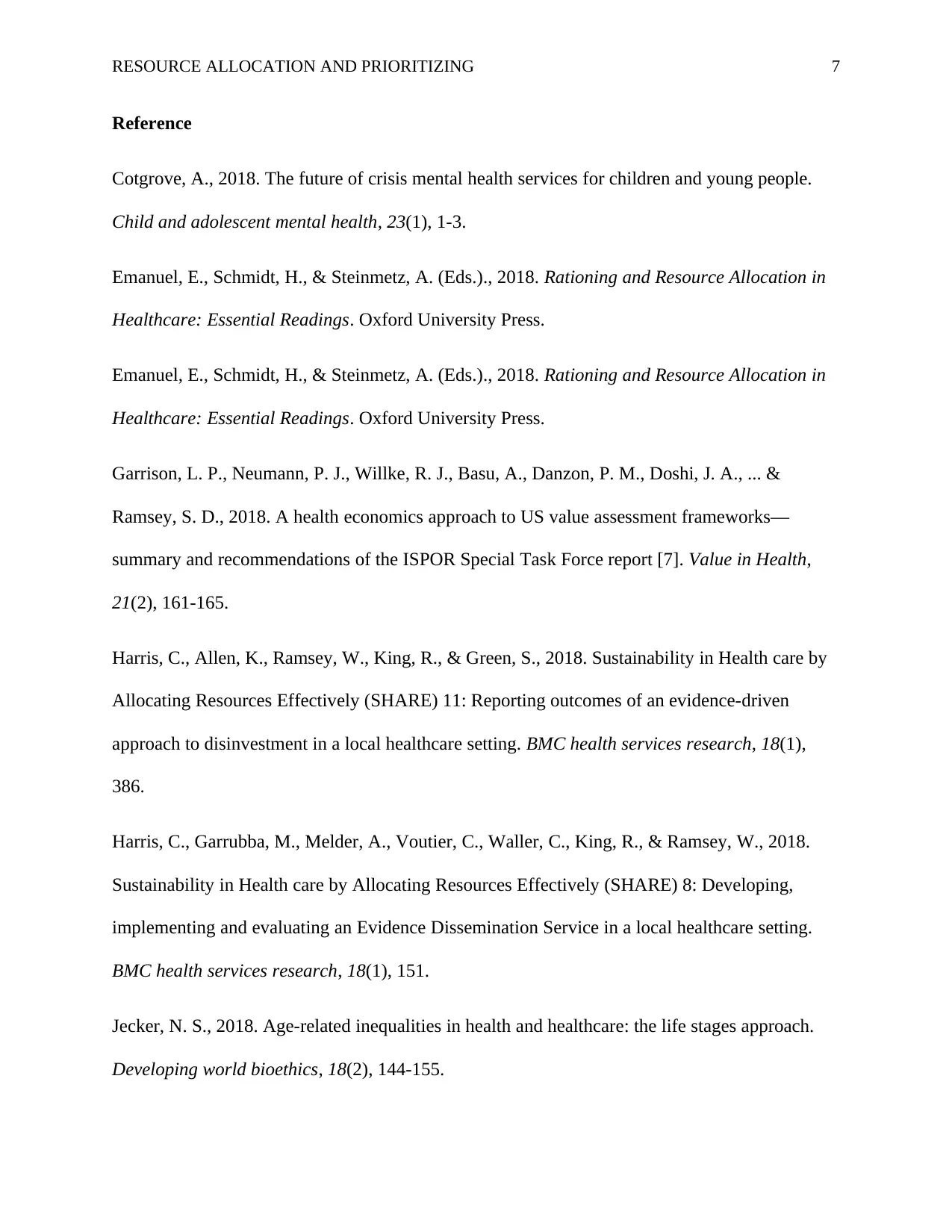
RESOURCE ALLOCATION AND PRIORITIZING 7
Reference
Cotgrove, A., 2018. The future of crisis mental health services for children and young people.
Child and adolescent mental health, 23(1), 1-3.
Emanuel, E., Schmidt, H., & Steinmetz, A. (Eds.)., 2018. Rationing and Resource Allocation in
Healthcare: Essential Readings. Oxford University Press.
Emanuel, E., Schmidt, H., & Steinmetz, A. (Eds.)., 2018. Rationing and Resource Allocation in
Healthcare: Essential Readings. Oxford University Press.
Garrison, L. P., Neumann, P. J., Willke, R. J., Basu, A., Danzon, P. M., Doshi, J. A., ... &
Ramsey, S. D., 2018. A health economics approach to US value assessment frameworks—
summary and recommendations of the ISPOR Special Task Force report [7]. Value in Health,
21(2), 161-165.
Harris, C., Allen, K., Ramsey, W., King, R., & Green, S., 2018. Sustainability in Health care by
Allocating Resources Effectively (SHARE) 11: Reporting outcomes of an evidence-driven
approach to disinvestment in a local healthcare setting. BMC health services research, 18(1),
386.
Harris, C., Garrubba, M., Melder, A., Voutier, C., Waller, C., King, R., & Ramsey, W., 2018.
Sustainability in Health care by Allocating Resources Effectively (SHARE) 8: Developing,
implementing and evaluating an Evidence Dissemination Service in a local healthcare setting.
BMC health services research, 18(1), 151.
Jecker, N. S., 2018. Age‐related inequalities in health and healthcare: the life stages approach.
Developing world bioethics, 18(2), 144-155.
Reference
Cotgrove, A., 2018. The future of crisis mental health services for children and young people.
Child and adolescent mental health, 23(1), 1-3.
Emanuel, E., Schmidt, H., & Steinmetz, A. (Eds.)., 2018. Rationing and Resource Allocation in
Healthcare: Essential Readings. Oxford University Press.
Emanuel, E., Schmidt, H., & Steinmetz, A. (Eds.)., 2018. Rationing and Resource Allocation in
Healthcare: Essential Readings. Oxford University Press.
Garrison, L. P., Neumann, P. J., Willke, R. J., Basu, A., Danzon, P. M., Doshi, J. A., ... &
Ramsey, S. D., 2018. A health economics approach to US value assessment frameworks—
summary and recommendations of the ISPOR Special Task Force report [7]. Value in Health,
21(2), 161-165.
Harris, C., Allen, K., Ramsey, W., King, R., & Green, S., 2018. Sustainability in Health care by
Allocating Resources Effectively (SHARE) 11: Reporting outcomes of an evidence-driven
approach to disinvestment in a local healthcare setting. BMC health services research, 18(1),
386.
Harris, C., Garrubba, M., Melder, A., Voutier, C., Waller, C., King, R., & Ramsey, W., 2018.
Sustainability in Health care by Allocating Resources Effectively (SHARE) 8: Developing,
implementing and evaluating an Evidence Dissemination Service in a local healthcare setting.
BMC health services research, 18(1), 151.
Jecker, N. S., 2018. Age‐related inequalities in health and healthcare: the life stages approach.
Developing world bioethics, 18(2), 144-155.
Paraphrase This Document
Need a fresh take? Get an instant paraphrase of this document with our AI Paraphraser
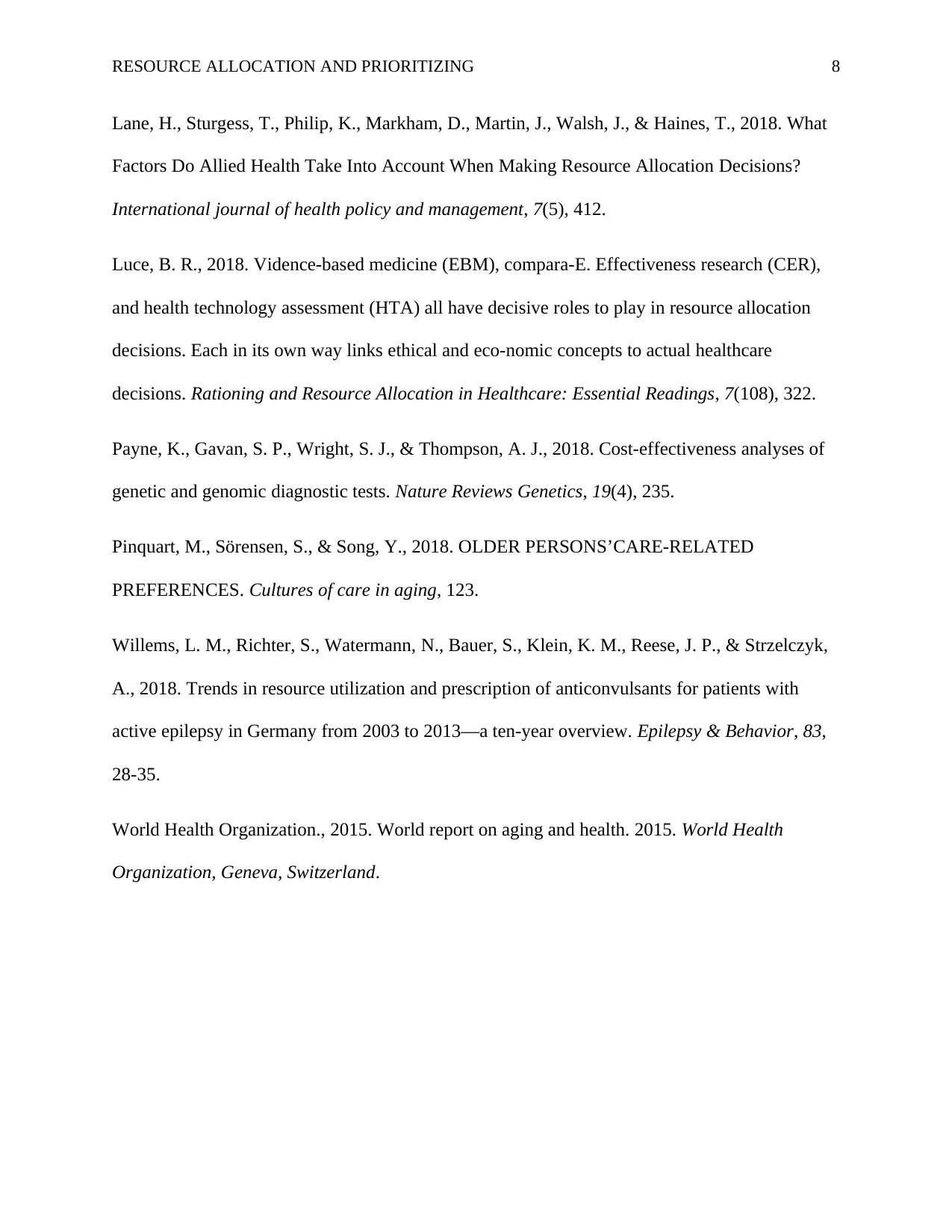
RESOURCE ALLOCATION AND PRIORITIZING 8
Lane, H., Sturgess, T., Philip, K., Markham, D., Martin, J., Walsh, J., & Haines, T., 2018. What
Factors Do Allied Health Take Into Account When Making Resource Allocation Decisions?
International journal of health policy and management, 7(5), 412.
Luce, B. R., 2018. Vidence-based medicine (EBM), compara-E. Effectiveness research (CER),
and health technology assessment (HTA) all have decisive roles to play in resource allocation
decisions. Each in its own way links ethical and eco-nomic concepts to actual healthcare
decisions. Rationing and Resource Allocation in Healthcare: Essential Readings, 7(108), 322.
Payne, K., Gavan, S. P., Wright, S. J., & Thompson, A. J., 2018. Cost-effectiveness analyses of
genetic and genomic diagnostic tests. Nature Reviews Genetics, 19(4), 235.
Pinquart, M., Sörensen, S., & Song, Y., 2018. OLDER PERSONS’CARE-RELATED
PREFERENCES. Cultures of care in aging, 123.
Willems, L. M., Richter, S., Watermann, N., Bauer, S., Klein, K. M., Reese, J. P., & Strzelczyk,
A., 2018. Trends in resource utilization and prescription of anticonvulsants for patients with
active epilepsy in Germany from 2003 to 2013—a ten-year overview. Epilepsy & Behavior, 83,
28-35.
World Health Organization., 2015. World report on aging and health. 2015. World Health
Organization, Geneva, Switzerland.
Lane, H., Sturgess, T., Philip, K., Markham, D., Martin, J., Walsh, J., & Haines, T., 2018. What
Factors Do Allied Health Take Into Account When Making Resource Allocation Decisions?
International journal of health policy and management, 7(5), 412.
Luce, B. R., 2018. Vidence-based medicine (EBM), compara-E. Effectiveness research (CER),
and health technology assessment (HTA) all have decisive roles to play in resource allocation
decisions. Each in its own way links ethical and eco-nomic concepts to actual healthcare
decisions. Rationing and Resource Allocation in Healthcare: Essential Readings, 7(108), 322.
Payne, K., Gavan, S. P., Wright, S. J., & Thompson, A. J., 2018. Cost-effectiveness analyses of
genetic and genomic diagnostic tests. Nature Reviews Genetics, 19(4), 235.
Pinquart, M., Sörensen, S., & Song, Y., 2018. OLDER PERSONS’CARE-RELATED
PREFERENCES. Cultures of care in aging, 123.
Willems, L. M., Richter, S., Watermann, N., Bauer, S., Klein, K. M., Reese, J. P., & Strzelczyk,
A., 2018. Trends in resource utilization and prescription of anticonvulsants for patients with
active epilepsy in Germany from 2003 to 2013—a ten-year overview. Epilepsy & Behavior, 83,
28-35.
World Health Organization., 2015. World report on aging and health. 2015. World Health
Organization, Geneva, Switzerland.
1 out of 8
Related Documents
Your All-in-One AI-Powered Toolkit for Academic Success.
+13062052269
info@desklib.com
Available 24*7 on WhatsApp / Email
![[object Object]](/_next/static/media/star-bottom.7253800d.svg)
Unlock your academic potential
Copyright © 2020–2025 A2Z Services. All Rights Reserved. Developed and managed by ZUCOL.





